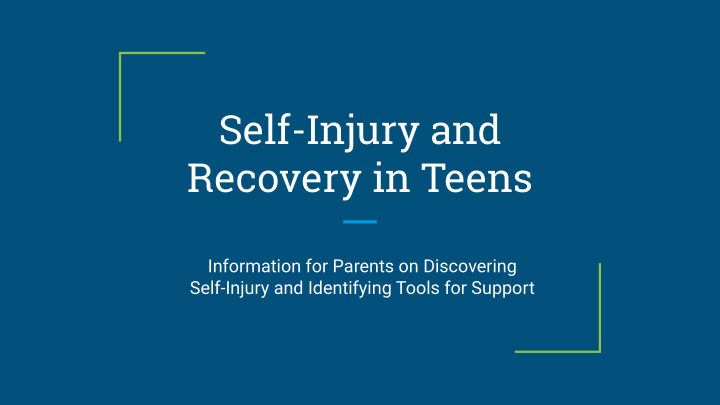



Self-Injury and Recovery in Teens Information for Parents on Discovering Self-Injury and Identifying Tools for Support
Objectives ● Identifying Self-Injury and Warning Signs ● Talking about Self-Injury with your Teen ● Understanding the Role of Relationships ● Activities and Resources to Manage Urges ● Self-Injury and the Home Environment ● Finding Treatment ● School Resources ● References for Seeking Help
Identifying Self-Injury and Warning Signs Self-injury or self-harm is defined as the intentional, direct injuring of one’s body, done without suicidal intent. How do I know if my child is self-injuring? ● Secrecy and withdrawal from others, physically and emotionally, for long periods of time (does not apply to all cases) ● Signs include: ○ Cut or burn marks on arms, legs and abdomen ○ Discovery of hidden razors, knives, sharp objects and rubber bands (may be used to increase blood flow or numb the area) ○ Spending long periods of time alone (key places include bathroom or bedroom) ○ Wearing clothing that does not match up with the weather (i.e. long sleeves and long pants in warm weather)
Talking about Self-Injury with your Teen ● Important to note the range of emotions as a parent ○ Shock, anger, sadness or guilt Acknowledge the behavior and emotional distress ● ● Address the issue as soon as possible (myth: “they will outgrow it”) ● Opening up lines of communication Validating feelings (calm, comforting, reassurance) ○ ○ Use concern constructively to show the impact that the behavior has on themselves and others ○ Difficulty verbalizing emotions Empathy vs. Sympathy ●
Brené Brown on Empathy
Understanding the Role of Relationships Self-Injury is often the result of: Person’s belief that they cannot handle the stress they feel ● ● Person’s faulty belief that self-injury is a good way to deal with stress Parent Relationships Focus on family dynamics; allies in the recovery process ● Peer Relationships ● “Second family” mindset (impact of negative peer group)
Activities and Resources ● Managing urges to self-injure - Brainstorm with your child Develop a list of support people and what they can specifically do to help at ○ different times of the day ○ Develop a “help card” with your child’s top coping strategies ■ Dig deeper - identify the true emotion you are feeling Match coping technique to your feeling ■
Activities and Resources Feelings and Coping Techniques ● Angry ○ Bring body temperature down - ice packs or cold bath ○ Slash an empty plastic soda bottle or a piece of heavy cardboard or an old shirt or sock ○ Squeeze ice ○ Flatten aluminum cans for recycling, seeing how fast you can go ● Craving something - feeling empty or unreal Squeeze ice ○ ○ List as many uses as possible for a random object (such as a twist tie) Bite into a hot pepper or chew a piece of ginger root ○ ○ Rub peppermint oil under your nose Slap a tabletop hard ○ ○ Take a cold bath or shower
Activities and Resources Feelings and Coping Techniques Guilty or like you’re a bad person ● ○ Read something good that someone has written about you Talk to someone that cares about you (refer to list of people who can help) ○ ○ Do something nice for yourself (paint nails, exercise, bake a treat, paint/draw) ● Sad or Depressed ○ Curl up under a weighted blanket with hot cocoa and a good book ○ Take a hot bath with oils or bubbles ○ Listen to a playlist of uplifting music ○ Make a tray of special treats ○ Visit a friend
Home Environment Negative family secrets can cause physical and/or psychological suffering. ● Encourage your child to share their feelings with a mental health professional, in or outside of school. Foster a protective home environment ● ○ Model healthy ways of managing stress (work out, see a therapist, use calm tones) Practice positive coping skills together (go to a concert or museum, go on a walk or run) ○ ○ Keep lines of communication and exchange open Emphasize and uphold the importance of family time ○ ○ Set limits and consistently enforce consequences. Consider positive consequences, such as serving in a soup kitchen ○ Respect the development of your child’s individuality Respect is a two-way street ○ ○ Avoid over-scheduling your child or putting too much pressure on them to perform Don’t expect a quick fix and understand that setbacks are a part of the process ○
Finding Treatment Consider individual, family, and/or group therapy ● ● Examples of local mental health providers: ○ Ashburn Psychological Services 703-723-2999 ○ The Wellness Connection 703-724-0335 ○ Loudoun Family and Relationship Counseling 703-771-7555 ○ Loudoun County Mental Health (emergency services) 571-258-3026 ○ Potomac Psychological Center 703-858-7838
School Resources https://www.lcps.org/Page/173753 Department of School Counseling ● Jaclyn Smith, Director of Counseling ● Erica Olinares, School Counselor (A-Fe) Jocelyn Culver, School Counselor (Fi-Le) ● Laura Northart, School Counselor (Li-Re) ● ● Maria Porto, School Counselor (Ri-Z) ● Amanda Williams, School Psychologist Nicolo Porto, School Social Worker ● Fiona Brown, Student Assistance Specialist ● Please contact us if you need referrals to mental health professionals
References Potomac Behavioral Solutions - https://www.pbshealthcare.com/ General stress-relieving techniques and management strategies: http://www.selfinjury.bctr.cornell.edu/factsheet_coping_alternatives.asp Self Injury Distraction Techniques and Alternatives: http://www.selfinjury.bctr.cornell.edu/documents/distraction-tech-and-alts.pdf “Helping Teens Who Cut: Understanding and Ending Self-Injury” by: Michael Hollander
Recommend
More recommend